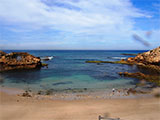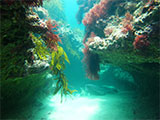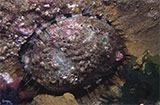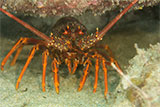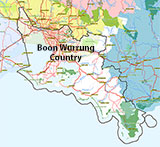Diamond Bay
![]() Reef Dive |
Reef Dive | ![]() Shore access
Shore access
![]()
![]()
![]()
![]()
![]()
![]()
![]()
Depth: 1 m (3.28 ft) to 10 m (33 ft)
Level: Advanced Open Water and beyond
Diamond Bay, named after the Diamond jubilee of Queen Victoria, is a popular family beach of Sorrento on the back beaches of the Mornington Peninsula surrounded by impressive sandstone cliffs. Diamond Bay faces south-west into Bass Strait.
What To Expect:
First off, to get to this dive site, which is amazing and not often dived, there is a bit of a walk. Over sand dunes and down the stairs, so this may not be for everyone, but if you have a good set of legs on you it is well worth it. It's about 130 m from the car park with the last 50 metres consisting of stairs and a walk across the soft sand of the beach.
It has many rock ledges and overhangs, kelp beds, reefs and small walls. In these is a variety of life including the odd crayfish! You'll also find old wives, boarfish, abalone, and schooling fish.
Another thing to be mindful is of the visibility, it can change quite quickly with the swell as it's a sandy bottom. It is advisable to go with someone who has been before also to come to the surface to check conditions and for navigational purposes every once in a while.
Diamond Bay Ocean Beach | Credit: David Bryant, Seapics
Now you can walk straight in from the stairs though you'll probably find more and avoid just looking at sand if you head over to the side and swim towards either point. Once you get about halfway along the bay is where the dive really starts and also begins to deepen. You'll find some bommies and kelp forest just before the point on the right-hand side — the direction usually taken.
Diamond Bay is a spectacular dive site but not often diveable. This site is more protected than other Mornington Peninsula Back Beach dive sites so when others are too rough this site can be okay.
Awesome looking landscape with lots of kelp, gullies, interesting rock formations and overhangs due to the surf pounding at the rocks. Not much macro life but you can find lots of crayfish and abalone (so bring a measuring device if you want to catch some), wrasse, sharks including catsharks and Port Jacksons and lots of leatherjackets.
Viz can be bad close to shore but clears up the further out you go if the weather is good. Weather can turn bad quickly so it can be helpful to check on conditions now and again throughout the dive. There are often rock fishermen on the east side of the bay on the cliff face or shallow rock ledge on the west so beware of their fishing lines.
If you're lucky enough to dive here on the right day everyone will be jealous. There aren't many facilities here so make sure you have everything you need including dive flag, knife, SMB and possibly a catch bag!
Location: Sorrento, Victoria 3943
MELWAY Ref: Page 157 B12.
Parking: Free parking at the end of Diamond Bay Road, Sorrento — fairly small so busy in summer. Before gearing up check out the water. If you see lots of white water, head on home.
Warning:As an ocean beach Diamond Bay is affected by rips, currents, swell and strong winds, thus can be very dangerous. Always go with a buddy and be extremely careful. Experienced divers and snorkellers only.
Entry/Exit: Via shore down steep stairs from the car park.
Ideal Conditions:
To dive here it must be calm with flat seas and very little to no swell. The only acceptable winds are light northerly to north-easterly. Be aware that conditions here can change very quickly. Very little swell (less than 6 ft, with periods of 10s or more) which generally means 3-4 days of northerly to north-easterly winds prior to diving here.
See WillyWeather (Diamond Bay Beach) as a guide for the tide times and the height of the tide.
Back Beach Warning: Always keep an eye on sea conditions throughout any dive on the Back Beaches of the Mornington Peninsula. Please read the warnings on the web page diving-the-back-beaches before diving or snorkelling this site.
See also, Parks Victoria: Diamond Bay and
Diamond Bay and the Bay Of Islands in "Shore Dives of Victoria" by Ian Lewis, 3rd edition page 115.
Diamond Bay is just a 10-minute drive from The Scuba Doctor Dive Shop. Please drop in and catch up with us before and/or after your dive.
Bay of Islands, Sorrento
The aptly named Bay of Islands lies to the east of Diamond Bay and is part of the Mornington Peninsula National Park. The craggy limestone rock formations create picturesque rocky outcrops (or islands) just off the coastline.
Divers have the opportunity to catch Abalone at this dive site. Remember your catch bag, legal abalone tool, current Victorian Recreational Fishing Licence, and abalone measure. Please abide by all current fishing regulations if you intend to catch abalone.
See article-catching-abalone for practical abalone hunting advice from The Scuba Doctor, plus melbourne-abalone-dives for a list of other Abalone dive sites near Melbourne.
Divers have the opportunity to catch Southern Rock Lobster (aka Crayfish) at this dive site. Remember your catch bag, current Victorian Recreational Fishing Licence, rock lobster measure, and cray tags. Once you get back to the dive boat, or shore, make sure you clip the tail and tag your Crayfish as per Fisheries requirements. Please abide by all current fishing regulations if you intend to catch crays. See article-catching-crayfish for practical cray hunting advice from The Scuba Doctor, plus melbourne-cray-dives for a list of other crayfish dive sites near Melbourne. For tips on cooking your Crays, please see article-cooking-crayfish.
Traditional Owners — This dive site is in the traditional Country of the Boon Wurrung / Bunurong people of the Kulin Nation. This truly ancient Country includes parts of Port Phillip, from the Werribee River in the north-west, down to Wilson's Promontory in the south-east, including the Mornington Peninsula, French Island and Phillip Island, plus Western Port. We wish to acknowledge the Boon Wurrung as Traditional Owners. We pay respect to their Ancestors and their Elders, past, present and emerging. We acknowledge Bunjil the Creator Spirit of this beautiful land, who travels as an eagle, and Waarn, who protects the waterways and travels as a crow, and thank them for continuing to watch over this Country today and beyond.
Diamond Bay Location Map
Latitude: 38° 21.246′ S (38.354105° S / 38° 21′ 14.78″ S)
Longitude: 144° 44.534′ E (144.742234° E / 144° 44′ 32.04″ E)
Datum: WGS84 |
Google Map
| Get directions
Added: 2012-07-22 09:00:00 GMT, Last updated: 2022-04-29 12:46:59 GMT
Source: Google Earth
Nearest Neighbour: Jubilee Point, 573 m, bearing 256°, WSW
Sorrento, Back Beaches, Mornington Peninsula.
Depth: 1 to 10 m.
[ Top ]
DISCLAIMER: No claim is made by The Scuba Doctor as to the accuracy of the dive site coordinates listed here. Should anyone decide to use these GPS marks to locate and dive on a site, they do so entirely at their own risk. Always verify against other sources.
The marks come from numerous sources including commercial operators, independent dive clubs, reference works, and active divers. Some are known to be accurate, while others may not be. Some GPS marks may even have come from maps using the AGD66 datum, and thus may need be converted to the WGS84 datum. To distinguish between the possible accuracy of the dive site marks, we've tried to give each mark a source of GPS, Google Earth, or unknown.

